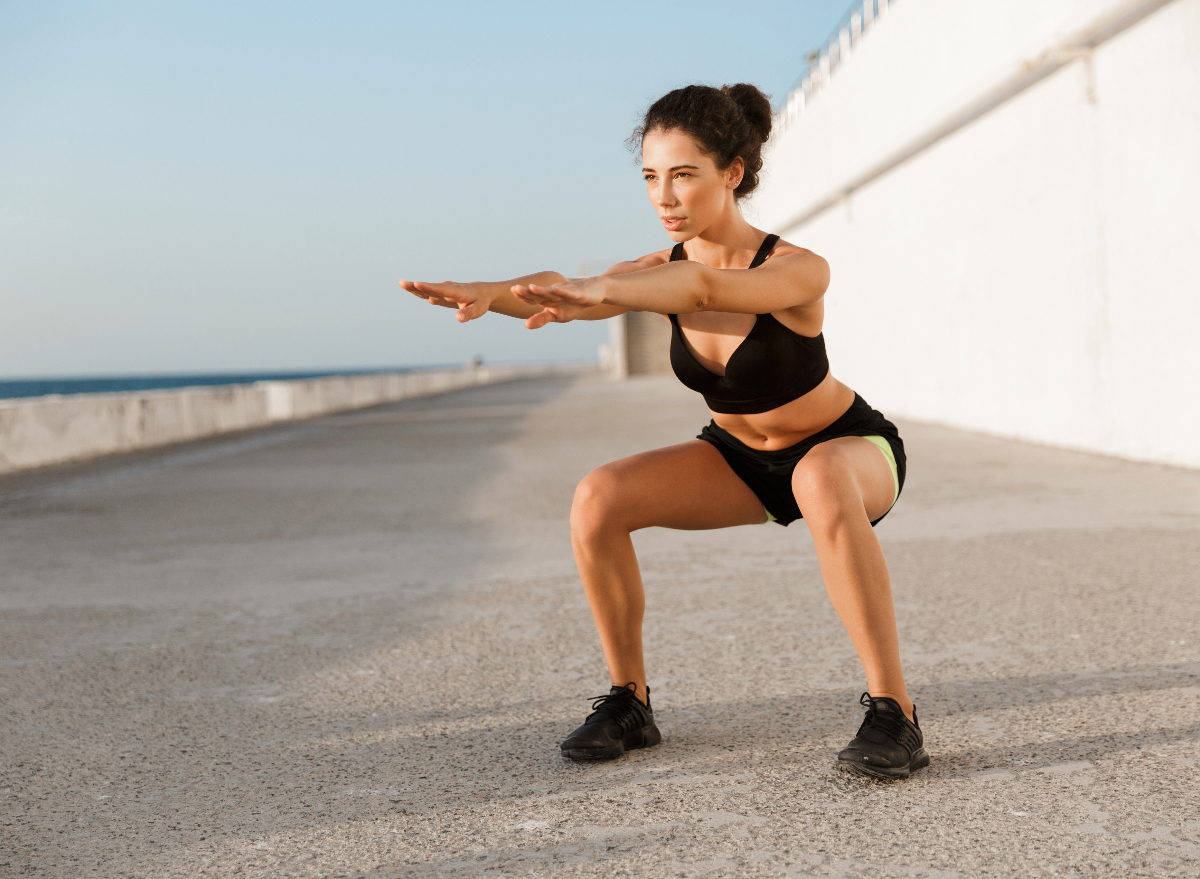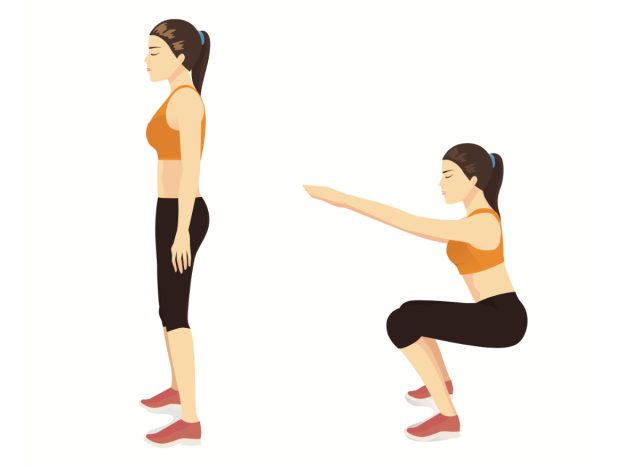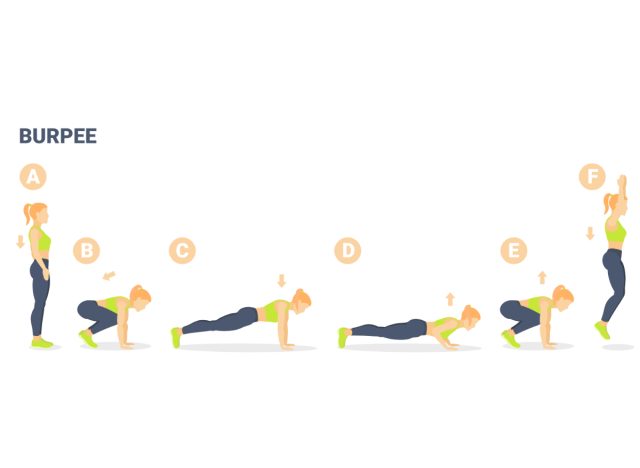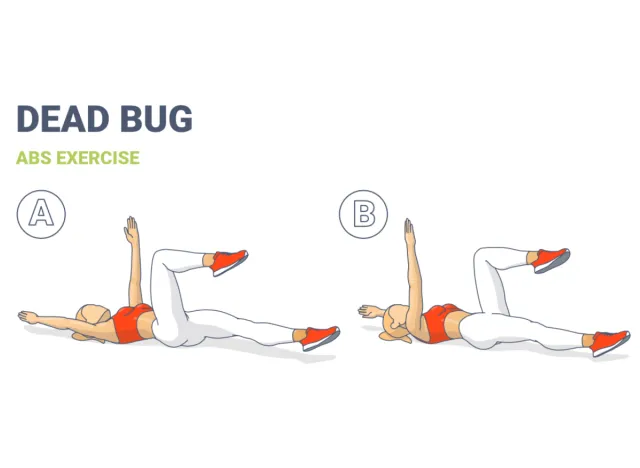Trainers Share Their Go-to Exercises When They Only Have 5 Minutes

When it comes to carving out time for workouts, sometimes all you have is five minutes to spare. But how can you make those five minutes the most effective they can possibly be? Dedicating just five minutes to exercise can still go a long way—so long as you have a few tried and true moves at your fingertips, recommended by the experts. Don’t fret, because Eat This, Not That! has you covered. We chatted with fitness pros who share their favorite five-minute exercises to do when they’re slim on time.
Take a look, and see what may work best for you! Keep reading to learn what trainers have to say about their go-to five-minute exercises. And when you’re finished, be sure to check out I Tried 4 Pairs of HOKA Sneakers & One Beats the Rest By a Mile.
Goddess Squat Pulses
When Ansley Davis, master trainer for YogaSix, only has five minutes of time, she turns to goddess squat pulses. “Goddess squats are a great way to build heat in the legs, plus these will warm up the hips in external rotation to alleviate any soreness or stiffness from sitting for any period of time,” Davis explains. This exercise comes with plenty of upper-body variations you can incorporate, such as spinal twists, shoulder rolls, and cactus arm cat/cows.
To perform goddess squat pulses, plant your feet in a wide sumo squat stance with your toes pointed out. Breathe in, and extend your arms overhead. Breathe out, and descend into a low squat. Lower your hands to your heart’s center. Repeat a few times while pulsing and keeping your breath consistent, then pause at the bottom of your squat and breathe freely. (You can also keep your arms extended that your sides.)
Squats

Michelle Parolini, senior master coach for Row House, is another fan of the squat. Parolini favors classic bodyweight squats, telling us, “I love squats because they are one of the most complete exercises you can do. Not only are you working the quads and glutes, [but] you’ll also work core stability, calves, hamstrings, abductors, and adductors. Depth of the squat and width of the foot placement can change up a squat!”
Doing squats will help you open up your knee, hip, and ankle joints. This exercise will fire up your legs from every angle. To begin, stand with your feet hip-distance apart. Keep your hands on your hips, or extend your arms ahead of you. Press your hips back as you lower into a squat, keeping your chest tall. Push through your feet to rise back up to standing.
Burpees with Pushups

“I know burpees can be a controversial move, because many people don’t enjoy them,” says Sasha Mihovilovic, NASM-CPT and master trainer for AKT. “I personally enjoy them when I am specifically doing a workout that is shorter! A burpee can be a fantastic quick hit move that will get your blood pumping, use the entire body, and can be regressed or progressed as much as you need at that moment.”
Start by placing your feet shoulder-width apart. Lower into a high plank, placing both hands under your shoulders and kicking your legs out behind you. Complete a pushup. As you rise back up, jump both feet up to meet your hands so you’re squatting down. Then, explosively jump up as you bring your arms overhead.
The great thing about this exercise is you can “walk it out” when you assume the plank position, drop down to both knees for the pushup, and make your way up again into a squat; these changes in levels will increase your heart rate. “A burpee can quickly be progressed to be more explosive (taking out the walk and adding jump back to plank), multiple pushup variations can be used, the speed can be amped up, and really challenge your body quickly in a short amount of time,” Mihovilovic explains.
Dead Bug

The “dead bug” is a quick go-to core exercise Alissa Tucker, NASM-CPT and master trainer for AKT enjoys. “I love this core exercise but I like to add an extra challenge by pressing the hand of the nonworking side into the knee on the same side,” Tucker says.
To perform the dead bug, lie down in a tabletop position. Press your right hand into your right knee, and your right knee into your right hand to create some resistance. Lengthen your opposite arm and leg, bringing them out and in gradually while focusing on your breath. “Inhale on the way out, exhale on the way in,” Tucker instructs. “Focus on making sure the lower back stays on the floor. This was one of my favorite exercises to help heal my diastasis recti after having a baby, and it’s one that I still incorporate almost daily.”
Another way to perform the dead bug is by lying down in a tabletop position. Lower your left arm and right leg at the same time until they’re fully extended. Bring them back up, and lower your right arm and left leg. Feel the burn in your core.
Jump Squats or Goblet Squats

Squats are getting a lot of love from trainers—and for good reason! Tucker specifically favors jump squats, because they bring your heart rate up in a speedy fashion and fire up the lower body while adding a power element to the movement.
“If you want to feel challenged by a five-minute workout, throw some jump squats in,” Tucker suggests. “If I am in the second half of my cycle (Luteal and Menstrual Phase) I will swap them out for goblet squats with a heavy weight to work the lower body without the cardio element,” she adds.
Begin in a squat with your hands at your heart’s center. Push through your feet to jump up and pull your hands down so they’re at the sides of your body. Bring them back to center as you land in a squat.
Single-Leg Deadlift to Back Row
On days when Jonathan Tylicki, NASM-CPT and director of education for AKT, is sitting at a desk for an extended period of time, this exercise comes in clutch. “[The single-leg deadlift to back row works] all of my posture muscles, and counteracts all of that sitting,” Tylicki explains. “The single leg work incorporates more balance as well, requiring the abs and core to stabilize the hips and low spine.”
Working with weights of your preference, step back to assume a staggered stance, bending your front leg just a bit, and keeping the majority of your weight in your front foot. Gradually hinge forward at the hips, maintaining a neutral, elongated spine. “When the lowest point of your hinge, draw the elbows back, pulling the weights to your hips, then extend the arms and slowly return to standing,” Tylicki adds.









